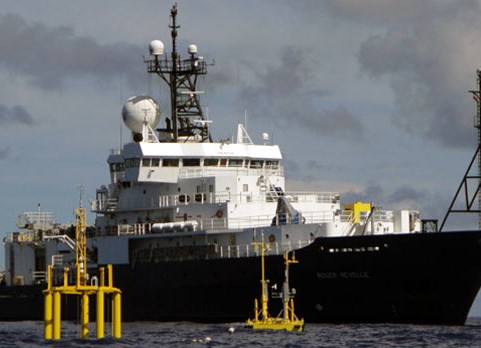
Electrical conductivity of seafloor unlocks new knowledge of slow-slip earthquakes

New learnings from international scientists’ voyage to New Zealand’s largest fault shows that earthquakes are affected by extinct, undersea volcanoes, called seamounts.
Christine Chesley from Columbia University says the research is getting closer to finding out how a subducting seamount might affect the structure and distribution of fluids in subduction zones, which impacts the types of earthquakes that occur there.
Ms. Chesley explained that the research the team is doing in the Hikurangi subduction zone shows that seamounts offshore the east cost of Gisborne are helping to create the slow-motion earthquakes that occur there.
Subduction is when two tectonic plates meet and one dives beneath the other, taking all the bumps, ridges, and extinct volcanoes on the ocean floor with it.
Slow slip events are common along the Hikurangi subduction zone, where the Pacific Plate is subducting under the Australian Plate. As the name suggests, the energy isn’t discharged through a sharp jolt (as for an earthquake) but slowly, over weeks to months.
Seamounts come in a range of sizes and shapes from bumps and ridges to mountain-like features that would have once risen higher than Mt Ruapehu under the sea.

Carrying out this interesting research is technically challenging because the seafloor being studied can sometimes be kilometers under the sea.
The scientists used a special technique that allowed them to figure out the electrical conductivity of rocks beneath the seafloor. “Seawater is an excellent conductor compared to most seafloor rocks, and so this method allows us to see where the water has infiltrated,” says Ms Chesley.
“By placing receivers on the seafloor offshore from Gisborne and towing an instrument that generated electromagnetic fields just above the receivers, we were able to calculate the conductivity of a seamount on the seafloor.”
The team found that the seamount was way more conductive than what they were expecting, and consistently so. This meant that the seamount was holding a lot of seawater inside of it like a sponge. “We also found pockets of rock in the Australian Plate that were conductive just above a subducting seamount. These conductive zones happened to overlap the location of recent seismic activity.”
These findings mean that seamounts carry water like a sponge, so when they subduct they can probably crack and crush pieces of the upper plate and potentially release water into these cracks. This water transfer could be related to some slow slip earthquakes.
This research is part of research into slow-slip earthquakes and fluid flow at the Hikurangi subduction zone and is a key finding from the R/V Revelle voyage in 2019.
10 February 2023
Disclaimers and Copyright
While every endeavour has been taken by the East Coast Lab Hikurangi Subduction Zone M9 to ensure that the information on this website is
accurate and up to date, East Coast Lab Hikurangi Subduction Zone M9 shall not be liable for any loss suffered through the use, directly or indirectly, of information on this website. Information contained has been assembled in good faith.
Some of the information available in this site is from the New Zealand Public domain and supplied by relevant
government agencies. East Coast Lab Hikurangi Subduction Zone M9 cannot accept any liability for its accuracy or content.
Portions of the information and material on this site, including data, pages, documents, online
graphics and images are protected by copyright, unless specifically notified to the contrary. Externally sourced
information or material is copyright to the respective provider.
© East Coast Lab Hikurangi Subduction Zone M9 - www.eastcoastlab.org.nz / +64 6 835 9200 / info@eastcoastlab.org.nz
